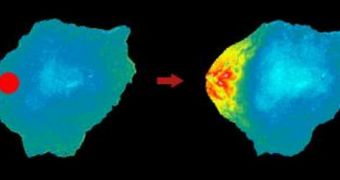For many years, experts have tried to gain a better understanding of cancer, of why it appears, and of how it spreads through the human body. In order to do this, they need to be able to observe and to control interactions that occur within a cell, especially at the individual protein level. Recently, breakthroughs have allowed researchers to observe how proteins are expressed or suppressed by various molecules, but investigators still need to learn how protein behavior influences the cell itself.
Now, scientists have just received a new tool for analyzing protein function, when a team of experts from the University of North Carolina School of Medicine, led by Klaus Hahn, PhD, has discovered a new way to manipulate the activity of proteins at specific places inside the cell using a little more than light. The team's method also enables it to control the protein at specific times, such as before or after it starts producing chemical signals that alter the movement or function of the cell itself.
Essentially, the new technology revolves around shining light only on a target cell, where the researchers want certain proteins to be active. Hahn is the UNC Thurman Professor of Pharmacology, and also a member of the UNC Lineberger Comprehensive Cancer Center. Details of the team's works are published in the latest issue of the respected scientific journal Nature.
“The technology has exciting applications in basic research – in many cases the same protein can be either cancer-producing or beneficial, depending on where in a cell it is activated. Now researchers can control where that happens and study this heretofore inaccessible level of cellular control. Because we first tested this new technology on a protein that initiates cell movement, we can now use light to control where and how cells move. This is quite valuable in studies where cell movement is the focus of the research, including embryonic development, nerve regeneration and cancer metastasis,” Hahn says.
The new method also sets itself apart as different and better than existing cellular-manipulation methods, because it does not have a negative effect on the cell itself. In other methods, proteins cannot be turned “off” once they are initiated, or the cellular membrane is breached while handling the cell. Other teams use light as well, but at disrupting frequencies that hamper with the natural activity of the targeted cell, PhysOrg reports.

 14 DAY TRIAL //
14 DAY TRIAL //